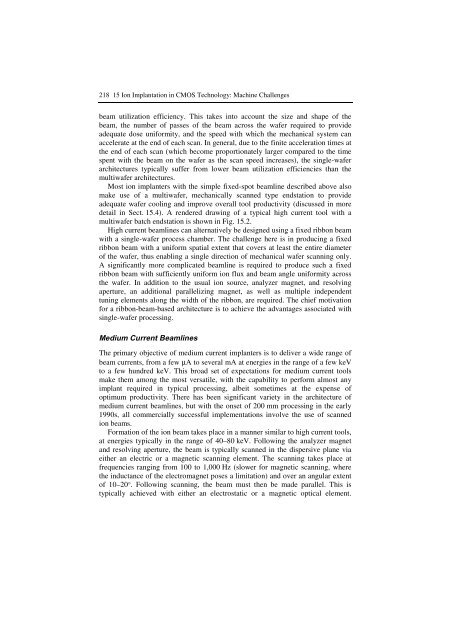Ion Implantation and Synthesis of Materials - Studium
Ion Implantation and Synthesis of Materials - Studium
Ion Implantation and Synthesis of Materials - Studium
You also want an ePaper? Increase the reach of your titles
YUMPU automatically turns print PDFs into web optimized ePapers that Google loves.
218 15 <strong>Ion</strong> <strong>Implantation</strong> in CMOS Technology: Machine Challengesbeam utilization efficiency. This takes into account the size <strong>and</strong> shape <strong>of</strong> thebeam, the number <strong>of</strong> passes <strong>of</strong> the beam across the wafer required to provideadequate dose uniformity, <strong>and</strong> the speed with which the mechanical system canaccelerate at the end <strong>of</strong> each scan. In general, due to the finite acceleration times atthe end <strong>of</strong> each scan (which become proportionately larger compared to the timespent with the beam on the wafer as the scan speed increases), the single-waferarchitectures typically suffer from lower beam utilization efficiencies than themultiwafer architectures.Most ion implanters with the simple fixed-spot beamline described above alsomake use <strong>of</strong> a multiwafer, mechanically scanned type endstation to provideadequate wafer cooling <strong>and</strong> improve overall tool productivity (discussed in moredetail in Sect. 15.4). A rendered drawing <strong>of</strong> a typical high current tool with amultiwafer batch endstation is shown in Fig. 15.2.High current beamlines can alternatively be designed using a fixed ribbon beamwith a single-wafer process chamber. The challenge here is in producing a fixedribbon beam with a uniform spatial extent that covers at least the entire diameter<strong>of</strong> the wafer, thus enabling a single direction <strong>of</strong> mechanical wafer scanning only.A significantly more complicated beamline is required to produce such a fixedribbon beam with sufficiently uniform ion flux <strong>and</strong> beam angle uniformity acrossthe wafer. In addition to the usual ion source, analyzer magnet, <strong>and</strong> resolvingaperture, an additional parallelizing magnet, as well as multiple independenttuning elements along the width <strong>of</strong> the ribbon, are required. The chief motivationfor a ribbon-beam-based architecture is to achieve the advantages associated withsingle-wafer processing.Medium Current BeamlinesThe primary objective <strong>of</strong> medium current implanters is to deliver a wide range <strong>of</strong>beam currents, from a few µA to several mA at energies in the range <strong>of</strong> a few keVto a few hundred keV. This broad set <strong>of</strong> expectations for medium current toolsmake them among the most versatile, with the capability to perform almost anyimplant required in typical processing, albeit sometimes at the expense <strong>of</strong>optimum productivity. There has been significant variety in the architecture <strong>of</strong>medium current beamlines, but with the onset <strong>of</strong> 200 mm processing in the early1990s, all commercially successful implementations involve the use <strong>of</strong> scannedion beams.Formation <strong>of</strong> the ion beam takes place in a manner similar to high current tools,at energies typically in the range <strong>of</strong> 40–80 keV. Following the analyzer magnet<strong>and</strong> resolving aperture, the beam is typically scanned in the dispersive plane viaeither an electric or a magnetic scanning element. The scanning takes place atfrequencies ranging from 100 to 1,000 Hz (slower for magnetic scanning, wherethe inductance <strong>of</strong> the electromagnet poses a limitation) <strong>and</strong> over an angular extent<strong>of</strong> 10–20°. Following scanning, the beam must then be made parallel. This istypically achieved with either an electrostatic or a magnetic optical element.
















